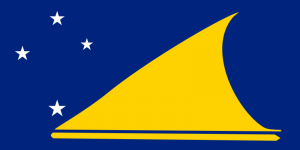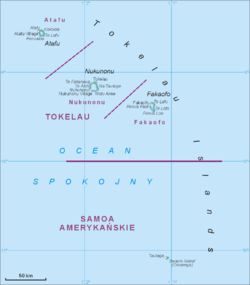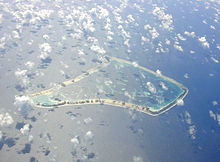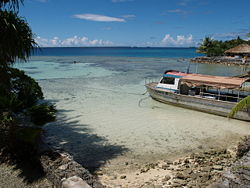Tokelau

Carving Family History – Tales from Te Papa
Traditional methods of making tools are often lost in the modern age; find out how Kupa and Jack, brothers from Tokelau, have kept alive their grandfather’s legacy by learning how to make adzes. TALES FROM TE PAPA is a fascinating new series of mini-documentaries for TVNZ 7 that showcase many of the exciting, wonderful and significant pieces that are held in our national museum. Tales from Te Papa is commissioned by TVNZ 7, in partnership with Te Papa. http://www.tepapa.govt.nz/talesfromte…
Tokelau /ˈtoʊkəlaʊ/ is a territory of New Zealand in the South Pacific Ocean that consists of three tropical coral atolls (from the northwest Atafu, Nukunonu and Fakaofo) with a combined land area of 10 km2 (4 sq mi) and a population of approximately 1,400. Its capital rotates yearly between the three atolls. Tokelau lies north of the Samoan Islands, Swains Island being the nearest, east of Tuvalu, south of the Phoenix Islands, southwest of the more distant Line Islands, and northwest of the Cook Islands.
The United Nations General Assembly designates Tokelau a Non-Self-Governing Territory. Until 1976, the official name was Tokelau Islands. It is a New Zealand territory, and is sometimes referred to by its older colonial name, the Union Islands.
Etymology
The name Tokelau is a Polynesian word meaning “North Wind”. The islands were named the Union Islands and Union Group by European explorers at an unknown time. Tokelau Islands was adopted as the name in 1946, and was contracted toTokelau on 9 December 1976.
Geography
 Map of all Tokelau Islands. Swains Island is shown to the south.
Map of all Tokelau Islands. Swains Island is shown to the south.
Tokelau includes three atolls in the South Pacific Ocean between longitudes 171°and 173° W and between latitudes 8° and 10° S, about midway between Hawaii and New Zealand. They lie about 500 km (311 mi) north of Samoa. The atolls are Atafu, Nukunonu, both in a group of islands once called the Duke of Clarence Group, and Fakaofo, once Bowditch Island. Their combined land area is 10.8 km2 (4 sq mi). There are no ports or harbours. Tokelau lies in the Pacific tropical cyclone belt. A fourth island that is culturally, historically, and geographically, but not politically, part of the Tokelau chain is Swains Island (Olohega), under United States control since about 1900 and administered as part of American Samoa since 1925.
Swains Island was claimed by the United States pursuant to the Guano Islands Act, as were the other three islands of Tokelau, which claims were ceded to Tokelau by treaty in 1979. In the draft constitution of Tokelau subject to the Tokelauan self-determination referendum in 2006, Olohega is claimed as part of Tokelau, a claim surrendered in the same 1979 treaty which established a boundary between American Samoa and Tokelau.
Tokelau’s claim to Swains is generally comparable to the Marshall Islands‘ claim to US-administered Wake Island, but the re-emergence of this somewhat dormant issue has been an unintended result of the United Nations‘ recent efforts to promote decolonization in Tokelau. Tokelauans have proved somewhat reluctant to push their national identity in the political realm: recent decolonization moves have mainly been driven from outside for ideological reasons. But at the same time, Tokelauans are reluctant to disown their common cultural identity with Swains Islanders who speak their language.
Environment
List of birds of Tokelau and List of mammals of Tokelau
Tokelau is located in the Western Polynesian tropical moist forests ecoregion. Most of the original vegetation has been replaced by coconut plantations some of which have been abandoned and became scrubby forests. The atolls of Tokelau provide habitat for 38 indigenous plant species, over 150 insect species and 10 land crab species. One of the greatest threats to biodiversity is posed by introduced mammalian predators such as the Polynesian Rat.
In 2011 Tokelau declared its entire exclusive economic zone of 319,031 km2(123,179 sq mi) a shark sanctuary.
History
Archaeological evidence indicates that the atolls of Tokelau — Atafu, Nukunonu, and Fakaofo — were settled about 1,000 years ago and may have been a “nexus” into Eastern Polynesia. Inhabitants followed Polynesian mythology with the local god Tui Tokelau; and developed forms of music (see Music of Tokelau) and art. The three atolls functioned largely independently while maintaining social and linguistic cohesion. Tokelauan society was governed by chiefly clans, and there were occasional inter-atoll skirmishes and wars as well as inter-marriage. Fakaofo, the “chiefly island,” held some dominance over Atafu and Nukunonu after the dispersal of Atafu. Life on the atolls was subsistence-based, with reliance on fish and coconut.
Western Discovery and Contact
Commodore John Byron discovered Atafu on 24 June 1765 and named it “Duke of York’s Island”. Parties onshore reported that there were no signs of current or previous inhabitants. Captain Edward Edwards, knowing of Byron’s discovery, visited Atafu on 6 June 1791 in search of the Bounty mutineers. There were no permanent inhabitants, but houses contained canoes and fishing gear, suggesting the island was used as a temporary residence by fishing parties. On 12 June 1791, Edwards sailed southward and discovered Nukunonu, naming it “Duke of Clarence’s Island.” A landing party could not make contact with the people but saw “morais,” burying places, and canoes with “stages in their middle” sailing across the lagoons.
On 29 October 1825 August R. Strong of the U.S.N Dolphin wrote of his crew’s arrival at the atoll Nukunonu:
“Upon examination, we found they had removed all the women and children from the settlement, which was quite small, and put them in canoes lying off a rock in the lagoon. They would frequently come near the shore, but when we approached they would pull off with great noise and precipitation.”
Fakaofo islanders, drawn in 1841 by the United States Exploring Expedition.
On 14 February 1835 Captain Smith of the United States whaler General Jacksonrecords discovering Fakaofo, calling it “D’Wolf’s Island.” On 25 January 1841, the United States Exploring Expedition visited Atafu and discovered a small population living on the island. The residents appeared to be temporary, evidenced by the lack of a chief and the possession of double canoes (used for inter-island travel). They desired to barter, and possessed blue beads and a plane-iron, indicating previous interaction with foreigners. The expedition reached Nukunonu on 28 January 1841 but did not record any information about inhabitants. On 29 January 1841, the expedition discovered Fakaofo and named it “Bowditch.” The islanders were found to be similar in appearance and nature to those in Atafu.
Missionaries preached Christianity in Tokelau from 1845 to the 1860s. French Catholic missionaries on Wallis Island (also known as ‘Uvea) and missionaries of the Protestant London Missionary Society in Samoa used native teachers to convert the Tokelauans. Atafu was converted to Protestantism by the London Missionary Society, Nukunonu was converted to Catholicism and Fakaofo was converted to both denominations.
Peruvian slave traders arrived in 1863 and took nearly all (253) of the able-bodied men to work as labourers. The men died of dysentery and smallpox, and very few returned to Tokelau. With this loss, the system of governance became based on the “Taupulega”, or “Councils of Elders”, where individual families on each atoll were represented. During this time, Polynesian immigrants and American, Scottish, French, Portuguese and German beachcombers settled, marrying local women and repopulating the atolls.
Until December 2011, Tokelau was 11 hours behind Coordinated Universal Time (UTC) At midnight 29 December 2011 Tokelau shifted to UTC+13:00 in response to Samoa’s decision to switch sides of the International Dateline. This brought Tokelau closer to New Zealand time (and in the process omitted 30 December).
Many sources claim that Tokelau is 14 hours ahead of UTC (UTC -10 before the 2011 date switch), but the correct time zone offset is UTC+13:00.
Government – Constitutional History of Tokelau
In 1877, the islands were included under the protection of the United Kingdom by an Order in Council which claimed jurisdiction over all unclaimed Pacific Islands. Commander C. F. Oldham on HMS Egeria landed at each of the three atolls in June 1889 and officially raised the Union Flag, declaring the group a British protectorate. In 1920, Tokelauans became recognised as British subjects.
The British government annexed Tokelau to the colony of the Gilbert and Ellice Islands and transferred Tokelau to New Zealand‘s administration in 1926, abolishing the islands’ chiefdoms. By the Tokelau Act of 1948, sovereignty over Tokelau was transferred to New Zealand. Defence is also the responsibility of New Zealand. When the British Nationality and New Zealand Citizenship Act 1948 came into effect on 1 January 1949, Tokelauans who were British subjects gained New Zealand citizenship – a status which they still hold.
Villages are entitled to enact their own laws regulating their daily lives and New Zealand law only applies where it has been extended by specific enactment. Serious crime is rare and there are no prisons – offenders are publicly rebuked, fined or made to work.
The head of state is Elizabeth II, the Queen in right of New Zealand, who also reigns over the United Kingdom and the other Commonwealth realms. The Queen is represented in the territory by acting Administrator Jonathan Kings. The current head of government is Foua Toloa, who presides over the Council for the Ongoing Governance of Tokelau, which functions as a cabinet. The Council consists of the Faipule (leader) and Pulenuku (village mayor) of each of the three atolls. The monarch is hereditary, the administrator appointed by the Minister of Foreign Affairs and Trade in New Zealand, and the office of head of government rotates between the three Faipule for a one-year term.
The Tokelau Amendment Act of 1996 confers legislative power on the General Fono, a unicameral body. The number of seats each atoll receives in the Fono is determined by population — at present, Fakaofo and Atafu each have seven and Nukunonu has six. Faipule and Pukenuku (atoll leaders and village mayors) also sit in the Fono.
On 11 November 2004, Tokelau and New Zealand took steps to formulate a treaty that would turn Tokelau from a non-self-governing territory to a self-governing state in free association with New Zealand. Besides the treaty, a United Nations-sponsored referendum on self-determination took place, with the three islands voting on successive days starting 13 February 2006. (Tokelauans based in Apia, Samoa, voted on 11 February.) Out of 581 votes cast, 349 were for Free Association, being short of the two-thirds majority required for the measure to pass. The referendum was profiled (somewhat light-heartedly) in the 1 May 2006 issue of The New Yorker magazine. A repeat referendum took place on 20–24 October 2007, again narrowly failing to approve self-government. This time the vote was short by just 16 votes or 3%.
In May 2008, the United Nations’ Secretary General Ban Ki-moon urged colonial powers “to complete the decolonization process in every one of the remaining 16 Non-Self-Governing Territories,” including Tokelau. This led the New Zealand Herald to comment that the United Nations was “apparently frustrated by two failed attempts to get Tokelau to vote for independence.” In April 2008, speaking as leader of the National Party, future New Zealand Prime Minister John Key stated that New Zealand had “imposed two referenda on the people of the Tokelau Islands”, and questioned “the accepted wisdom that small states should undergo a de-colonisation process.”
Economy
According to the US Central Intelligence Agency‘s list of countries by GDP (PPP)Tokelau has the smallest economy of any country in the world. Tokelau has an annual purchasing power of about US$1,000 (€674) per capita. The government is almost entirely dependent on subsidies from New Zealand. It has annual revenues of less than US$500,000 (€336,995) against expenditures of some US$2.8 million (€1.9 million). The deficit is made up by aid from New Zealand.
Tokelau annually exports around US$100,000 (€67,000) of stamps, copra and woven and carved handicrafts and imports over US$300,000 (€202,000) of foodstuffs, building materials, and fuel to, and from, New Zealand. New Zealand also pays directly for the cost of medical and education services. Local industries include small-scale enterprises for copra production, wood work, plaited craft goods, stamps, coins, and fishing. Agriculture and livestock produces coconuts, copra, breadfruit, papayas, bananas, figs, pigs, poultry and a few goats. Many Tokelauans live in New Zealand and support their families in Tokelau through remittances.
Tokelau has plans to only use renewable energy. If this is achieved it will be the only nation to have achieved this goal. It is expected that by mid-2012 Tokelau’s electricity supply will be 93% generated by photovoltaics, with the remainder generated from coconut oil. On 7 November 2012, the islands have met these goals and become the first territory in the world to meet all of their electricity needs from solar power, according to the Foreign Affairs Minister of New Zealand, Murray McCully.
Internet Domain Names
Tokelau has increased its GDP by more than 10% through registrations of domain names under its top-level domain, .tk. Registrations can be either free, in which case the user owns only usage rights and not the domain itself, or paid, which grants full rights. Free domains are pointed to Tokelau name servers, which redirects the domain via HTML frames to a specified address or to a specified A or NS record, and the redirection of up to 250 email addresses to an external address (not at a .tk domain). Free domains have no requirements for third party advertisements but have a minimum traffic limit of 25 unique visitors in any 90-day period. If this limit is not reached, the domain is suspended and the owner has 10 days to either convert the domain to a paid domain or have the domain deregistered.
In September 2003 Fakaofo became the first part of Tokelau with a high-speed Internet connection. Foundation Tokelau financed the project. Tokelau gives most domain names under its authority away to anyone for free to gain publicity for the territory. This has allowed the nation to gain enhanced telecommunications technologies, such as more computers and Internet access for Tokelauan residents. By 2012, there were about 120 computers, mostly laptops, and 1/6th of the economy consists of income from .tk domain names.
Solar Power
Three solar power stations are planned to provide 100% electricity from photovoltaics, with battery backup. The first power station was completed in August 2012. In total, 4,032 solar panels will be used and 1,344 batteries weighing 250 kg each, and make Tokelau the first nation in the world to be 100% powered by solar power. The systems are designed to withstand winds of 230 km/h (143 mph). Previously electricity was generated using diesel generators, and was only available about 16 hours/day.
Demographics
 The atoll of Fakaofo, southernmost of the Tokelau Islands.
The atoll of Fakaofo, southernmost of the Tokelau Islands.
According to the 2011 Tokelau Census, Tokelau has a de jure usually resident population of 1,411 people. The census shows a 3.8% decrease in the de jure usually resident population between 2006 and 2011.
The nationals of Tokelau are called Tokelauans, and the major ethnic group isPolynesian. The country has no minorities. The major religion is the Congregational Christian Church and the main language is Tokelauan, but English is also spoken.
Tokelau has fewer than 1,500 Polynesian inhabitants in three villages. Their isolation and lack of resources greatly limits economic development and confines agriculture to the subsistence level. The very limited natural resources and overcrowding are contributing to emigration to New Zealand and Samoa, resulting in a population decline of about 0.9% per year. Depletion of tuna has made fishing for food more difficult.
On the island of Atafu almost all inhabitants are members of the Congregational Christian Church of Samoa. On Nukunonu almost all are Roman Catholic. On Fakaofo both denominations are present with the Congregational Christian Church predominant. The total proportions are: Congregational Christian Church 62%, Roman Catholic 34%, other 5%.
While slightly more females than males live on Atafu and Fakaofo, males make up 57% of Nukunonu residents. Only 9% of Tokelauans aged 40 or more have never been married. One-quarter of the population were born overseas; almost all the rest live on the same atoll they were born on. Most households own 5 or more pigs.
Despite its low income, Tokelau has a life expectancy of 69 years, comparable with other Oceania islands.




